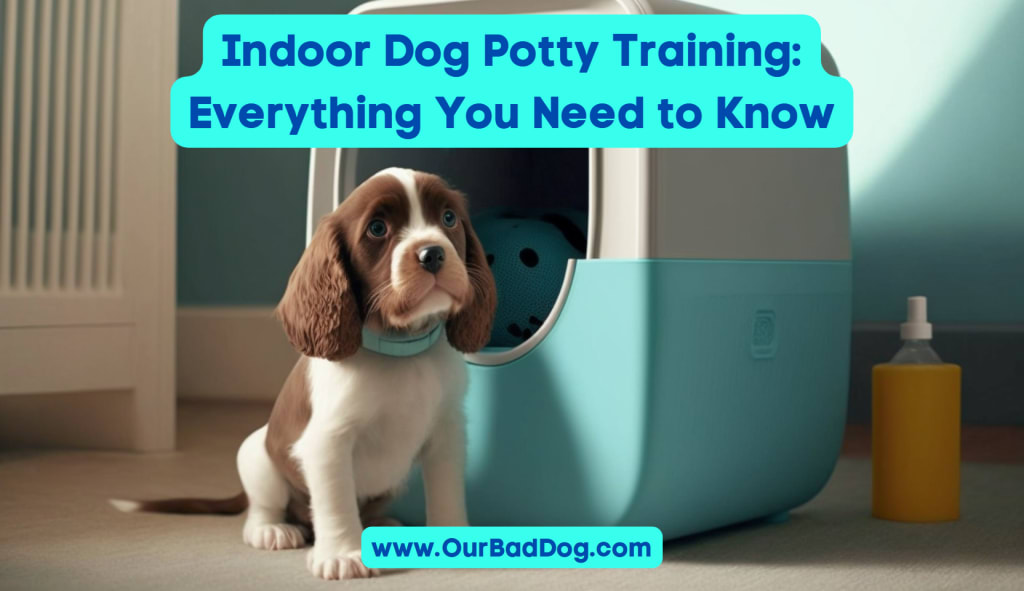
Dog potty training is one of the most important aspects of raising a happy and healthy dog. A well-trained dog can save you from the hassle of cleaning up accidents and ensure that your home remains clean and odor-free. While outdoor potty training is the preferred method for most dog owners, indoor potty training can be a lifesaver for those who live in apartments, have limited access to outdoor areas, or have dogs with special needs. In this article, we will discuss everything you need to know about indoor potty training for dogs.
Indoor Potty Training Options
When it comes to indoor potty training, there are several options to choose from. The most popular indoor potty options include pee pads, artificial grass, litter boxes, and dog potty systems.
Pee pads are a popular choice among dog owners as they are affordable, easy to use, and readily available. They are absorbent pads that you can place on the floor, and they are an excellent option for small dogs or puppies. Pee pads can be used as a temporary solution or for dogs that have difficulty going outside due to health issues or other reasons.
Artificial grass is another popular option for indoor potty training. It mimics the look and feel of real grass, making it easier for dogs to transition from indoor to outdoor potty areas. Artificial grass is easy to clean, durable, and can be used for both small and large dogs.
Litter boxes are more commonly used for cats, but they can also be used for small dogs. Litter boxes are typically made of plastic or other durable materials and filled with litter that absorbs urine and controls odor.
Finally, dog potty systems are a more high-tech option that automatically cleans and disposes of waste. These systems use a combination of sensors, filters, and cleaning agents to ensure that the indoor potty area remains clean and odor-free.
👉Check out this amazing wi-fi enabled, self cleaning smart potty pad!
Setting Up the Indoor Potty Area
Once you have chosen the indoor potty option that works best for you and your dog, it's time to set up the designated potty area. Choose a location in your home that's easily accessible for your dog but away from their food and water bowls. The area should also be easily accessible for you, as you will need to clean and maintain the indoor potty area regularly.
Place the potty option in the designated area and surround it with a barrier to prevent accidents. This will also help your dog understand that this is their designated potty area. You can also use scents or attractants to encourage your dog to use the designated potty area. Many indoor potty options come with attractants that can help your dog associate the area with going potty.
Training Your Dog to Use the Indoor Potty Area
When it comes to training your dog to use the indoor potty area, consistency is key. Take your dog to the designated potty area at regular intervals, such as after meals, naps, and playtime. Puppies, in particular, may need to go to the potty area more frequently as they have smaller bladders and may not be able to hold it as long as adult dogs.
Reward your dog with praise or treats when they use the potty area correctly. Positive reinforcement is essential in potty training, as it helps your dog understand that going potty in the designated area is a good thing. If your dog has an accident, clean it up promptly and avoid scolding or punishing your dog, as this can create fear and confusion.
👉10 Reasons Why Your Dog Ignores Your Commands
Frequently Asked Questions:
How long does it take to potty train a dog indoors?
The amount of time it takes to potty train a dog indoors can vary depending on several factors such as the dog's age, breed, and personality. Some dogs may learn quickly and take only a few weeks to potty train, while others may take several months. It's essential to remain patient and consistent throughout the process and avoid punishing your dog for accidents.
Can indoor potty training be used for puppies?
Yes, indoor potty training can be used for puppies, and it's best to start potty training as early as possible to establish good habits. Puppies have smaller bladders, so they'll need to go more frequently than adult dogs. Be sure to take them to the designated potty area at regular intervals, reward them for using it correctly, and clean up any accidents promptly.
How often should I take my dog to their indoor potty area?
It's recommended to take your dog to their designated indoor potty area at least every 2-3 hours, after meals, naps, and playtime. If your dog is showing signs of needing to go, such as sniffing around or circling, take them to the potty area immediately. Remember to praise and reward your dog for using the potty area correctly to encourage good habits.
Can indoor potty training be used for all dog breeds?
Yes, indoor potty training can be used for all dog breeds, but larger breeds may require a more substantial indoor potty area. Consider your dog's size when choosing a potty option and designate a specific area for them to go.
👉The well behaved dog of your dreams is waiting to emerge.
How do I transition my dog from indoor potty training to outdoor potty training?
To transition your dog from indoor potty training to outdoor potty training, start by gradually moving the indoor potty closer to the door leading to the outdoor potty area. Once your dog is comfortable using the outdoor potty area, gradually remove the indoor potty. Remember to be patient and consistent throughout the process and reward your dog for successful outdoor potty breaks.
Finally, remember that indoor potty training is just one aspect of overall house training for your dog. It's essential to also train your dog to go potty outside, as well as to follow basic commands and socialize with other dogs and humans. Consistency, patience, and positive reinforcement are key to successfully training your furry friend and creating a happy, healthy living environment for both you and your dog.
In conclusion, indoor potty training can be a challenging but necessary task for dog owners, especially for those who live in apartments or have limited outdoor space. By choosing the right indoor potty option, setting up a designated potty area, establishing a routine, and providing positive reinforcement, you can successfully train your dog to use an indoor potty and avoid accidents in your home. Remember to be patient, understanding, and consistent throughout the training process, and don't forget to continue training your dog to go potty outside and follow basic commands. With time and effort, your dog will become a well-trained, happy companion.
This article contains affiliate links. If you use these links to buy something we may earn a commission. Thanks!





Comments
There are no comments for this story
Be the first to respond and start the conversation.